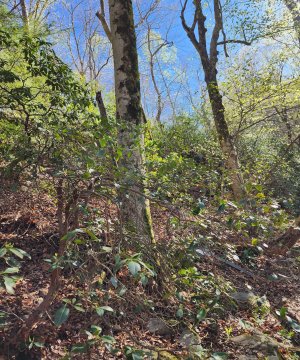Lower Piedmont Acidic River Bluff Forest
Scenario model
Current ecosystem state
Select a state
Management practices/drivers
Select a transition or restoration pathway
-
Transition T1A
Clearcut logging or other large-scale disturbances that cause canopy removal.
More details -
Transition T1B
Selective removals of the most valuable timber specimens, leaving inferior trees behind.
More details -
Transition T2A
Long-term natural succession.
More details -
Transition T3A
Clearcut logging or other large-scale disturbances that cause canopy removal.
More details -
No transition or restoration pathway between the selected states has been described
Target ecosystem state
Select a state
Description
This mature forest state typically supports a somewhat open to sparse tree canopy with a closed and often dense, ericaceous shrub layer. Though usually sparse, acid-tolerant and drought-tolerant species occupy the herb layer. This ecological site exhibits a high level of variability with respect to species composition and vegetation structure, depending primarily on aspect and the degree of exposure to the elements, among other factors.
Characteristics and indicators
Stands are uneven-aged with at least some old trees present.
Description
This successional phase develops in the wake of clearcut logging, storm-related catastrophic tree mortality, or other large-scale disturbances that have led to canopy removal in the recent past. Which species colonize a particular location in the wake of a disturbance does involve a considerable degree of chance. It also depends a great deal on the type, duration, and magnitude of the disturbance event.
Characteristics and indicators
Plant age distribution is even. Plants exhibit pioneering traits such as rapid growth, early reproduction, and shade-intolerance.
Submodel
Description
This state develops as a consequence of high-grading, where the most valuable trees are removed, leaving less desirable timber specimens behind. Trees left behind include undesirable timber species, trees of poor form, diseased trees, or genetically inferior trees.
Characteristics and indicators
Typically, high-graded stands consist of a combination of residual stems from the previous stand, a high proportion of undesirable shade-tolerant species, along with some regrowth from desirable timber species. In some cases, large-diameter trees of desirable timber species may be present, but upon closer inspection, these trees usually have serious defects that resulted in their being left behind in earlier cuts.
Resilience management
Landowners with high-graded stands have two options for improving timber production: 1) rehabilitate, or 2) regenerate. To rehabilitate a stand, the landowner must evaluate existing trees to determine if rehabilitation is justified. If the proportion of high-quality specimens present in the stand is low, then the stand should be regenerated. In many cases, poor quality of the existing stand is the result of decades of mismanagement. Drastic measures are often required to get the stand back into good timber production.
Mechanism
The reference state can transition to the secondary succession state through clearcut logging or other large-scale disturbances that cause canopy removal.
Mechanism
The reference state can transition to the high-graded hardwood forest state through selective removal of the most valuable trees, leaving undesirable timber specimens behind. This may occur through multiple cutting cycles over the course of decades or longer, each cut progressively worsening the condition of the stand.
Mechanism
The secondary succession state can transition to the reference state through long-term natural succession. This process can be accelerated to some degree by a combination of prescribed burns and selective harvesting of pines and opportunistic hardwoods.
Model keys
Briefcase
Add ecological sites and Major Land Resource Areas to your briefcase by clicking on the briefcase (![]() ) icon wherever it occurs. Drag and drop items to reorder. Cookies are used to store briefcase items between browsing sessions. Because of this, the number of items that can be added to your briefcase is limited, and briefcase items added on one device and browser cannot be accessed from another device or browser. Users who do not wish to place cookies on their devices should not use the briefcase tool. Briefcase cookies serve no other purpose than described here and are deleted whenever browsing history is cleared.
) icon wherever it occurs. Drag and drop items to reorder. Cookies are used to store briefcase items between browsing sessions. Because of this, the number of items that can be added to your briefcase is limited, and briefcase items added on one device and browser cannot be accessed from another device or browser. Users who do not wish to place cookies on their devices should not use the briefcase tool. Briefcase cookies serve no other purpose than described here and are deleted whenever browsing history is cleared.
Ecological sites
Major Land Resource Areas
The Ecosystem Dynamics Interpretive Tool is an information system framework developed by the USDA-ARS Jornada Experimental Range, USDA Natural Resources Conservation Service, and New Mexico State University.

